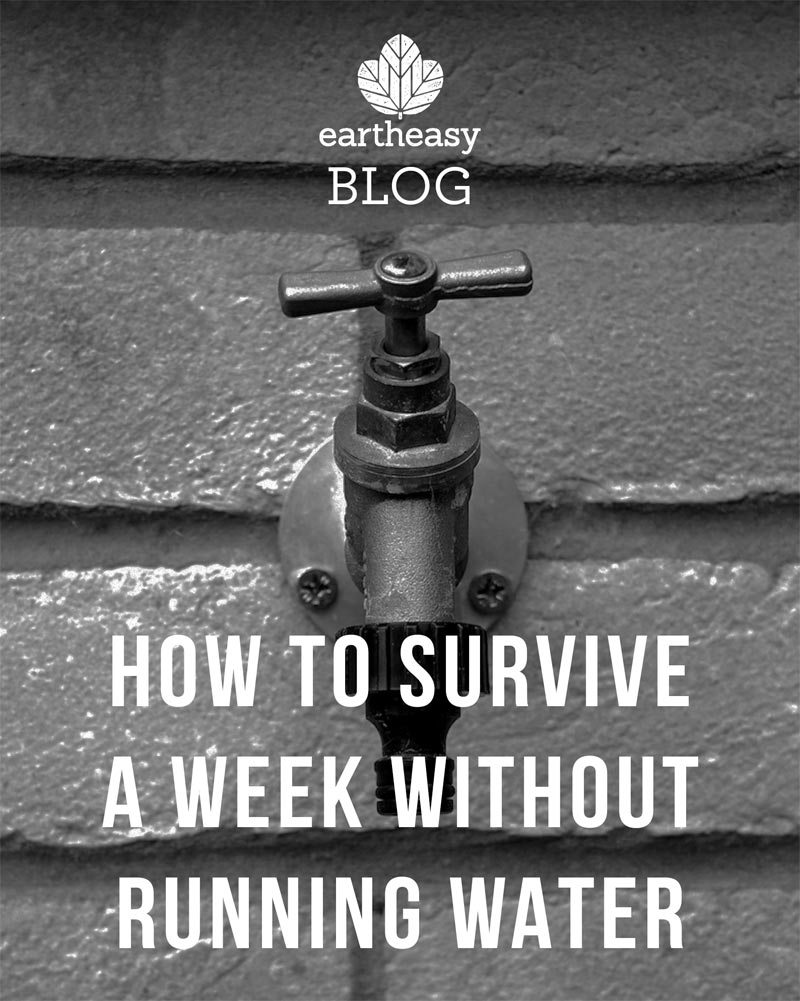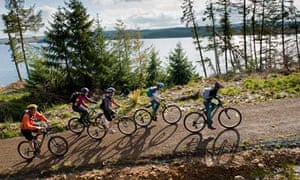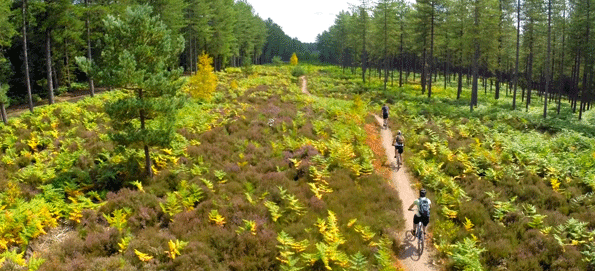Author
By NICOLE FAIRES
The foundation of every disaster plan is clean water.
The average American uses approximately 80 – 100 gallons of water per day, with the largest percentage of that being flushed down the toilet. Our consumption is one of the highest in the world, even when compared to many other first world countries, such as Great Britain, where the average person uses about 40 gallons per day.
Imagine for a moment that you’re like the millions of people who recently found themselves without running water for a week or more. Would you be ready to live without at least 560 gallons of water?
Related:
Where Your Water Goes
On average, your household water consumption is made up of the following uses:
80-100 gallons per day = about 32,000 gallons per year
Along with this, each person has a greater water cost from food, transportation, and other hidden water uses. The bulk of this ‘water footprint’ is from agriculture: livestock grazing, cotton, soybeans, wheat, fodder crops, coffee, barley and corn, for a grand total of 751,777 gallons of water per person, per year.
Factors Affecting Your Water Source

The water we use directly and indirectly every day comes from groundwater, surface water, and rainwater. Each of these sources is becoming less reliable due to climate change, an aging infrastructure, and industry.
Climate Change
According to the Environmental Protection Agency, our changing climate is altering the hydrologic cycle, changing the amount, timing, form, and intensity of precipitation. Other expected changes include the flow of water in watersheds, as well as the quality of aquatic and marine environments.
Where you live will have a big impact on how climate change will impact your water sources. With greater extremes of weather, flooding and drought, a climate that is already somewhere in the middle or colder will have greater stability.
The midwestern and northeastern United States are expected to experience the greatest temperature increases, which means extreme heat waves. Meanwhile, some areas will get much more precipitation, or far less of it. And many places will have stronger cold seasons.
In the northern US, winter is expected to get worse, but there will be less rain in the summer. The Pacific Northwest is supposed to get less precipitation overall and experience colder temperatures. Meanwhile, the South is going to be a lot drier. These changes will not be the same as small weather patterns, but will hit hard and have consequences for agriculture and health.
Clean and accessible groundwater is already becoming very valuable and harder to find. Analysis of U.S. Geological Survey has shown that water levels nationwide in the United States have dropped 64% due to fracking and agriculture, with an average decline of more than 10 feet.
Even more alarming, the declines were consistent even in wet areas, and not dependent on drought. The US Office of the Director of National Intelligence ranked water scarcity as a major threat to national security in 2016.
Aging Infrastructure
To compound the problem, the United States is using a water system nationwide that is rapidly falling apart. Thousands of cities have cast iron pipes that date back to the 1880s and many more cities have a serious lead problem. Maintaining the current water treatment and pipe system for a growing population is already stretching the economy (which we have seen in Flint, Michigan).
Replacing these systems often only happens when pipes burst and cause millions of dollars in damage—like the town of Warren, Michigan, which had to declare a state of emergency after suffering 107 breaks in a month. Despite these issues, it seems that legislation and funding just isn’t happening fast enough.
Being Prepared for a Water Emergency

To fully prepare for a water emergency, you’ll need to consider what factors affect the area where you live and what type of emergency you might encounter. You’ll also need to calculate how much water your family uses and how much you’ll need to replace for a short-term emergency situation.
The Federal Emergency Management Agency (FEMA) recommends one gallon per person (or pet) per day for up to two weeks—and that’s just for drinking. If you plan to cook, shower, wash dishes or clothing, you’ll need to replace considerably more than that.
Once you’ve made your calculation, consider the following solutions.
Water Purification
A reliable water purification system is vital when you’re in a situation where water is still plentiful, but it’s not clean, such as when a storm or flooding damages clean water sources or the city declares that the water isn’t safe to drink due to failed infrastructure.
Most jug-style filters don’t remove heavy metals like lead and other contaminants. The Berkey Light Water Purification System reduces the concentration of lead and other heavy metals in the water by over 97%. It also requires no electricity and can filter up to 3,000 gallons.
For compact water filters that are easy to stow, the LifeStraw Family 1.0 can filter up to 4,750 gallons of water, removing viruses, bacteria, and protozoa. The Lifestraw Personal Water Filter easily fits into emergency kits in your home or car. Each one filters 264 gallons of water.
For survival situations where contamination from heavy metals and waterborne illnesses are a threat, consider filtering by distillation. A still uses heat to turn water into steam, leaving contaminants behind. You can get a portable survival model which can even desalinate ocean water.
Storing Municipal Water
Whether or not you have a water filter on hand for drinking water, it’s wise to store water for drinking and other uses.
Unfortunately not all water storage solutions are created equally. Many plastic containers contain harmful chemicals, such as BPA. Plastic or waxed cardboard containers that once contained milk or fruit juice can encourage the growth of harmful bacteria. Glass containers aren’t ideal either, because they’re not earthquake proof and can break during a flood.

Outside of purchasing bottled water, the Centers for Disease Control and Prevention (CDC) recommends using food grade containers manufactured for storing water. Containers like the WaterBrick are made from durable food grade industrial plastic and hold 3.5 gallons each. They can stack compactly into a small area, saving you a ton of space. They are also portable enough to take with you if you ever have to evacuate.
To prepare any plastic container for storage, wash thoroughly before filling, making sure to carefully rinse any soap residue from the inside of the container. Next, sanitize each container by swishing with a quarter cup of bleach mixed into one cup of water. Thoroughly rinse your container with clean water to remove all of the sanitizing solution.
If your municipality treats your tap water with chlorine, go ahead and fill your containers. If you’re storing well water or water that hasn’t been treated, add two drops of liquid household bleach for each gallon of water. Replace your stored water every six months.
Rainwater Storage
Depending on where you live and your roofing materials, rainwater storage is another viable alternative for your emergency water supply. Consider these facts:
- For every inch of rainfall on 1,000 square feet of roof, you can collect 600 gallons of water.
- The average home has a roof area of 1,500 square feet.
- A desert is an area that gets less than 10 inches of water a year.
While it may not supply all of your needs, a 60-gallon rain barrel can supplement your drinking water and provide an extra supply for cooking, laundry, and washing. (If you’re unsure whether your stored rainwater is suitable for drinking, have a test kit on hand to check the water yourself.)
Combined with 16 WaterBricks, a single rain barrel could supply you with over 110 gallons of water without much storage space, enough to get a family through an entire week if combined with the water-saving solutions below. For more information on rainwater storage, read our article: Harvesting Rainwater for Residential Security.
Getting Ready to Use Less Water
In most water emergencies, you’ll need to reduce your water consumption dramatically. Since we’ve seen that most of our water gets flushed down the toilet, a Honeybucket chemical toilet or the Potty Box can take care of 26% of your water consumption.
Another 21% of your water use is in the laundry. Not only will you be wearing clothes a lot longer than you would otherwise, you’ll need to make some hard choices about some eco-friendly items. If you are using cloth diapers, cloth pads, and washable cleaning cloths and rags, you will need to keep a supply of disposable diapers, pads, sterilizing wipes, and paper towels on hand.

A Scrubba™ Wash Kit will allow you to do your laundry with a tiny amount of water and no washing machine. Washing clothes by hand in your bathtub or sink is laborious and doesn’t do the job effectively. The Scrubba cleans clothes in three minutes with very little water.
Keeping clean is another huge challenge without running water, yet hygiene is important in an emergency situation. Use a Simple Shower attachment to create a shower head out of a two liter bottle and keep a large supply of Action Wipes on hand to maintain a normal level of cleanliness. Action Wipes are extra large wet wipes that are safe to use on the whole body, including kids’ bodies, and have a sudsy but quick-drying cleaning solution.
Peace of Mind
Wherever you live, chances are you’ll sleep better at night if you plan ahead and secure enough water for your needs. With a few thoughtful steps, you can ensure that you and your family can weather a water emergency.
Have you been without water for a week? What was the most surprising challenge you experienced?
Pin for later:


~~
Nicole Faires is an urban farmer and best-selling author of books on sustainable agriculture and food policy. Originally from Montana, she now lives with her family on the West Coast. Find out more at http://deliberatelife.ca or connect with her on LinkedIn.
For further information log on website :
http://learn.eartheasy.com/2017/09/survive-week-without-running-water/




















